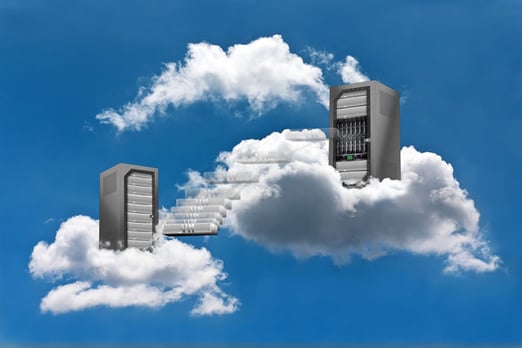
These days, most vendors offer the ability to deploy their ERP system in the cloud, but that doesn’t mean the traditional on-premise solution should go away. On-premise and cloud-based ERP systems can and do coexist for several reasons.
- Each business is unique with different requirements and circumstances. And those circumstances can vary extensively based on the processes and areas the ERP application is covering.
- An industry’s location, functions or resources might dictate what type of system would work best for companies in that industry. And in other cases, the application requirements of an industry/company will dictate whether on-demand or cloud is best.
- While cloud-based solutions used to be available only to certain organizations, things are changing. As technological advances have made connectivity more stable and available at higher capacities, cloud-based systems are within reach of organizations that have traditionally stuck with on-premise systems.
On-premise or cloud solution?
The decision between on premise or cloud comes down to many factors: budget, deployment options, security, etc.
Key advantages of an on-premise software solution are as follows:
- One-time pricing under some sort of license fee
- An organization might be concerned about access to sensitive information and feel more secure with their information being isolated in their own environment.
- A company might know exactly what they want for a solution and it is simply not offered as a cloud-based configuration. They go with the on-premise option because it fits their business best.
- Some organizations require lots of customization of the software they select, and the comparable cloud-based system is less flexible for such tailoring.
And here are key advantages of a cloud-based software solution:
- Generally, a cloud-based platform incurs a recurring fee, making the initial price of the system much lower than an on-premise solution.
- A cloud-based solution reduces resources for an organization, including hardware upgrades and IT personnel.
- Multi-location access issues are easily resolvable. Cloud-based solutions synchronize invisibly in the company.
- While a cloud-based solution doesn’t give a company complete control of software security, security is generally better and at a higher level (and with many more security layers) than the organization would be able to do on their own.
- Disaster recovery is built into the cloud-based provider’s deployment, ensuring instant access to your code and important company data.
Start with a needs analysis
Before selecting a platform, you must analyze your software needs. Those will vary, but here are a few examples of common needs/challenges from past clients of ERP Advisors Group:
- The ability to integrate with existing platforms
- The ability to maintain extensive control over an application’s code and data
- The need to customize and build specific models that might change regularly
- A lack of IT infrastructure in place
- A need for flexibility and versatility
- Industry security protocols
Sometimes a company has a very particular application that suits their needs. Not all applications are available both ways, so the company must go with the application—which they know will meet their company requirements—and accept that it is either cloud based or on premise.
There are many reasons to go with a cloud-based platform, just as there are reasons to choose on-premise software. It really depends on your requirements. Need guidance? Contact the team at ERP Advisors Group today. We’ll discuss your needs and guide you through the process of selecting a solution that fits your organization best.
Cara Plahuta: Can On-Premise and Cloud-Based Systems Coexist?
Quentin Dewitt is our speaker for today. Quentin has been in the information technology business for over 20 years. He has led teams as a director of IT, brought innovative products to market as a product manager, and led large teams as a director of technical support.
Today he provides leadership and guidance to our consulting team through a wide variety of technical knowledge, experience, and skill. Along with being a Microsoft Certified Professional, administrator, systems engineer, and an experienced consultant in the ERP space, Quentin manages the ERP Advisors Group team on needs analysis, software selection, and implementation services.
On today's call, Quentin will discuss on-premise and cloud-based software systems and whether the two can coexist. Why do some companies choose to go cloud whereas some do not? And why would a company go cloud for some enterprise solution but not others?
Quentin, if you are ready I can pass it along to you.
Quentin Dewitt: Yes, thank you, Cara. Very much appreciated the introduction.
So, the overarching question is, can on-premise and cloud-based systems coexist? And the simple answer to that is yes, on-premise and cloud-based solutions can and do coexist.
In the current market and with the current trends and software platforms, it sometimes seems as that that may not be true, but we have found through our real experiences and varied industries and so forth that it actually is.
There are many reasons for this and some of the reasons for that are that there are different requirements and circumstances for every individual business, and these can vary extensively based on the process and area that application is covering.
In some cases and industries, location, functions, or resources will dictate if they should go cloud-based or on-premise. And for others, it is the process and application requirements that dictate which direction you would go in.
With that being the case, we are seeing more and more organizations that have specific initiatives to move all applications to the cloud. And this can be for various reasons, sometimes resource-based, sometimes it's accessibility, remote access, things like that.
But as technology advances, making more connectivity stable and available at higher capacities, it puts the cloud-based solutions and systems within reach of these organizations. So that's why we've been seeing that trend of moving more in the direction of cloud-based solutions.
There's a lot more that could be said around this, but those are the overall trends and we are seeing that they can coexist.
So, to go from there, what is the difference between on-premise and cloud-based deployment?
Well, we'll first define what an on-premise solution is, and that is where software is installed directly on hardware that resides within the business itself — so, on location in your server room or sometimes in a closet, sometimes in multiple locations. It depends on the size of organization and how developed your IT infrastructure is. So, that's your general on-premise solution.
Now cloud-based solutions are generally anything other than that.
There are actually different versions of cloud-based solutions, so I'll go through a few different styles or types of cloud-based deployments that you might have.
The first is a software application installed at a data center that you still take care of and manage yourself, so this is often called cloud, but it's also called hosted or hosting your environment and an example of this — a provider of this is hosting.com.
Next we get to a hybrid of that and what we might call true cloud. But the next is where software is installed at a data center and someone else is actually managing and taking care of all the upgrades, maintenance, etc.
This is usually called managed services and the company doing that for you often provides the hosting of the hardware, sometimes they provide the installation and setup of that hardware and application. Usually they'll provide the support and they'll provide potentially customer support or IT support as well to the client. So, that's one version of cloud as well. And depending upon the provider, they may do all of it, or they may only do some of it and still share some of that responsibility with the individual client. So, your IT system or infrastructure or personnel may interact with that directly, or it may be completely managed by that hosted managed service provider.
The third and largest group of these for many of the larger applications is that you have no idea where the application is installed. You never see the hardware. A lot of the times this is actually hosted on servers that the vendors themselves are managing — the software vendor is managing. So, there is a huge amount of infrastructure, security, and so forth that's going on in the background that you as the client or the purchaser of the software never see. And that's typically what most larger enterprises call cloud. There's not really usually another name for it than the cloud.
So, this is typically seen, and I would say from larger enterprise software vendors, and this is the direction most of those are going with their cloud solution is a completely invisible infrastructure to the client.
So, from that it leads on to the next question, which is why organizations do each type of deployment. And there are many reasons for this, some of the most common reasons for this are that for on-prem it gives you the most control over your application and allows you to use your own resources to manage it. That's one of the reasons people go on-premise.
So additionally, there are often security concerns around access or intellectual property and the organization feels more secure with all that isolated inside of their own environment. Sometimes this is truly the case, other times it's not more secure or there's other variables involved with that.
And then sometimes if it’s on-prem it’s strictly necessitated by the process or location not allowing cloud-based solutions to function such as a mine for instance, if you had to interact with the software application and you had no signal and no way to get signal to a remote location, you might use an on-premise application or something like that.
So, then another reason for on-prem solutions is sometimes it's just not available on a cloud-based configuration or setup. The vendor doesn't offer it and it is the right application, so the client will go with an on-prem solution when that's the only form it comes in.
So, on the flip side of that with cloud-based deployments, it puts most of the management in professional hands. It can be a huge reduction in resources for the client and their need to manage and handle the infrastructure and all the hardware and expenses for running that when you have a cloud-based solution.
Additionally, many times it makes multi-location access issues easily resolvable. Say you're spread out across the entire country and you have many locations that in a normal on-premise solution you'd have to interconnect these and make the communication of the different data between each location synchronize, and this can often cause a lot of overhead. Well, the cloud-based solutions manage that all invisibly to the client. It's all handled and accessible from wherever you happen to be, but can be locked down to certain locations if you choose.
So that's one of the other reasons why you might deploy in a cloud-based solution.
The next is that, often, the reason that you might go with the cloud-based solution is while it doesn't allow you complete control of the security, it's often being provided a much higher level and a better security layer than you could provide on your own. Many organizations have a smaller IT infrastructure that may not have their core focus and extreme security measures to protect from hacking, fraud, different things like that, intellectual property protection, maybe it's just disaster recovery.
So, these larger cloud-based solutions often have all of that infrastructure in place with many layers and much higher levels of security than you can provide on your own. So that's another reason you might deploy in the cloud-based setup.
So, the next question really, and that leads into it, is when to know which deployment style is right for you. And again, this will vary from organization to organization, and each should do an analysis to truly understand what the right path is for your needs.
And that very often can vary based on a number of different elements from where you are, what type of platform it is, what your needs are, department to department, if you need to integrate to other applications.
So, which deployment method is right for you should be determined up front before you start looking at software packages, whether on-premise or cloud-based. Really define those needs to move forward from there.
So, I'll give you some examples on a couple of choices for an on-premise and why we went in that direction for that particular client.
One client was around a $500 million distributor, and they had to go on-premise due to integrations with existing platforms and a need for really extensive control over the application itself, meaning that they needed to write customizations, build specific software modules that might change on a regular basis in order to meet their business’s needs.
And the cloud platforms that they were looking at just couldn't handle that sort of flexibility and that level of control that they were requiring as one of their selection criteria.
So additionally, they were migrating off of a 30-year-old application and because of the interconnectivity and the integration with that older application, it just made the right choice to be that on-premise solution that they had direct access to modify database and connectivity and even reprogram the API to do what they needed — so that's the application interface.
So, that was making the on-prem solution the right decision for that organization.
So, I'll give you another example that is actually going in the direction of cloud, but it was an early-stage software company with little IT resources, so they were very well developed on the development of their software platform, but they didn't necessarily have the IT infrastructure to support all of the applications that they needed to run.
A lot of their staff worked remotely from across the country and what they really needed was a next generation application that was extremely flexible and versatile. In that case, a cloud-based solution handled all of their requirements, made it easily accessible, and they could just concentrate on their core business functionality and it worked out perfectly for them.
So those are a couple examples, one on-prem, one on cloud-based.
So, I wanted to go from there into really explaining that there is a third scenario and sometimes it is completely based off of the application that fits your needs, dictating whether you're on-premise or if you're in the cloud.
Some applications do not truly come in one flavor or the other, and you just have to go with your need in that area and really just select the software based off of your requirements versus whether it's cloud-based or an on-premise solution.
So, I think that covers the main points that I really wanted to go over with you and there are many reasons why you might go cloud-based versus on-prem, and the reverse is often true.
So, if you have any questions or need more information on that you can definitely reach out to us — ERP Advisors Group — and we can help you through this process to truly understand what your requirements are, what your needs are, and which direction would be best for you to go in.
So with that, thank you, Cara, for passing this over to me and I'll pass it back to you to wrap up.
Cara: Great thank you, Quentin. And thank you again for joining us on today's call. Please let us know if we can answer any questions you have.
Our next call is on October 8th and the topic is The Growing Role of Cybersecurity in ERP.
In this next edition The ERP Advisor we will discuss how to protect your most vital enterprise applications with simple cybersecurity best practices. Please go to our website erpadvisorsgroup.com for more details and to register.





